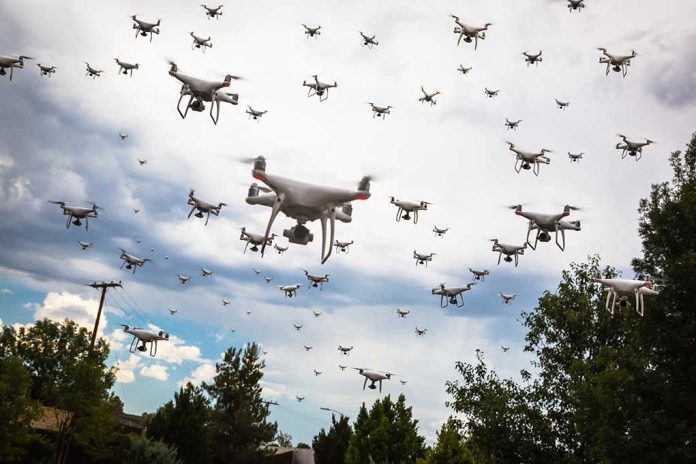
The Pentagon’s $1 billion Replicator Initiative aims to produce thousands of drones by 2025, turning the Taiwan Strait into an “unmanned hellscape” to deter Chinese aggression.
Key Takeaways
- The U.S. is ramping up drone production to counter China’s military threats, particularly regarding Taiwan.
- China’s drone capabilities are rapidly advancing, with a fleet potentially ten times larger than Taiwan and the U.S. combined.
- The Pentagon’s strategy involves deploying drone swarms to delay a potential Chinese attack on Taiwan.
- Challenges include U.S. industrial capacity to produce drones at scale compared to China’s manufacturing advantages.
- Both nations are investing heavily in AI and autonomous systems for military applications.
Pentagon’s Drone Strategy to Counter China
The U.S. Department of Defense is intensifying its focus on drone production as part of a strategic plan to counter potential threats from China. This initiative, known as the Replicator Initiative, aims to produce thousands of drones by August 2025. The $1 billion program is designed to create what Navy Admiral Samuel Paparo described as an “unmanned hellscape” in the Taiwan Strait, deterring Chinese aggression and buying time for U.S. and allied forces to respond in case of conflict.
The strategy reflects a shift in modern warfare, where unmanned aerial vehicles (UAVs) play an increasingly crucial role in surveillance, reconnaissance, and combat operations. By prioritizing advanced drone technologies, the Pentagon aims to maintain a cutting-edge defense posture against global adversaries, particularly China’s growing military capabilities.
China’s Advancing Drone Capabilities
China’s progress in drone technology has not gone unnoticed. The world’s largest commercial drone manufacturer is rapidly expanding its military drone capabilities. According to Michael Raska, an expert on the subject, “China’s military is developing more than 50 types of drones with varying capabilities, amassing a fleet of tens of thousands of drones, potentially 10 times larger than Taiwan and the U.S. combined.”
Michael Raska, assistant professor at Singapore’s Nanyang Technological University, said, “China’s military is developing more than 50 types of drones with varying capabilities, amassing a fleet of tens of thousands of drones, potentially 10 times larger than Taiwan and the U.S. combined.”
This development has raised concerns within the U.S. defense community. China’s dominance in the consumer drone market, primarily through companies like DJI, could potentially benefit its military in a drone conflict. The Pentagon’s recent report highlights China’s advancements in UAV modernization, including systems like the WZ-7 Soaring Dragon and the redesigned GJ-11 stealth unmanned combat air vehicle.
U.S. Response and Challenges
The U.S. military’s response to China’s drone advancements involves not only increasing production but also developing new strategies for deployment. The plan includes using drone swarms for various military functions, from intelligence gathering to guiding missiles. However, the U.S. faces significant challenges in this drone race.
Policy fellow at George Mason University, Zachary Kallenborn, said, “The benefits of unmanned systems are that you get cheap, disposable mass that’s low cost. If a drone gets shot down, the only people that are crying about it are the accountants. You can use them at large amounts of scale and overwhelm your opponents as well as degrade their defensive capabilities.”
One major hurdle is the U.S. defense industrial base’s capacity to produce the necessary quantities of drones. China’s established manufacturing infrastructure gives it a significant advantage in drone production and deployment. To address this, the Pentagon is exploring ways to foster both commercial and military drone production to scale up and create surge capacity.
The Role of AI and Future Warfare
Both the U.S. and China are heavily investing in AI-enabled technologies for military applications. The Chinese government prioritizes AI for autonomous vehicles, predictive maintenance, logistics, and automated target recognition. By 2030, the People’s Liberation Army (PLA) aims to field ‘algorithmic warfare’ and ‘network-centric warfare’ capabilities with AI integration.
The U.S. is similarly focused on integrating AI into its military systems. Admiral Christopher Grady emphasized the ongoing nature of this technological arms race, stating, “This is just the beginning.” As both nations continue to advance their drone and AI capabilities, the future of warfare is likely to be shaped by these unmanned systems and artificial intelligence.
As tensions persist in the Indo-Pacific region, particularly regarding Taiwan, the drone race between the U.S. and China remains a critical aspect of modern military strategy. The Pentagon’s focus on creating an “unmanned hellscape” reflects the evolving nature of deterrence and combat readiness in the 21st century.
Sources:
- https://www.voanews.com/a/us-taiwan-china-race-to-improve-military-drone-technology/7713168.html
- https://defensescoop.com/2024/12/18/chinas-drone-modernization-efforts-close-to-matching-us-standards-pentagon-report-says/
- https://www.wired.com/story/china-taiwan-pentagon-drone-hellscape/
- https://www.youtube.com/watch?v=OmztCyZD5rI










